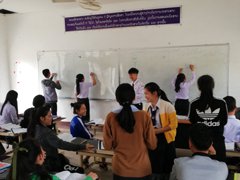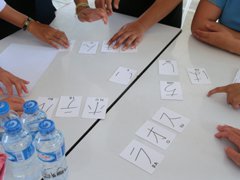Second Japanese Major Course Created for a Laotian University
National University of Laos
TANABE Tomonari
Located in the interior of Southeast Asia, Laos is a mountainous country rich in natural beauty that has not so much experienced the foreign manufacturing investment and large scale industrialization. However, Laos has recently started serving as a transit point for China, with the likelihood of an international highway framework becoming a reality, one that would connect central inland China with Thailand and Malaysia in the north and south direction, and Vietnam (and the South China Sea) with Myanmar (Andaman Sea) in the east and west direction. Meanwhile, Special Economic Zones (SEZ) are being established and interest in foreign investment is rising.
Whereas the population of Laos is just under 7 million people, the number of Japanese language learners has remained only about 1,000 in recent years according to the Survey on Japanese-Language Education Abroad 2015 by the Japan Foundation, with only about 150 people taking the Japanese-Language Proficiency Test (JLPT) annually. This is the second lowest number in Southeast Asia after Brunei. While the country’s ranking remains the same, I sense that a change is occurring among Japanese language learners here.
The number of applicants for the most recent JLPT in December 2017 was only 214, but the number of actual test takers, 195, was in fact the highest for the country since the test began, although it didn't surpass the 200 mark. At the National University of Laos, where I work, the number of students is rising, with a rise in Japanese language majors, with more 3rd year students than 4th year, and more 2nd year students than 3rd year.
There have been two recent occurrences that symbolize the situation here in Laos. The first is that Japanese-language education was begun for some lower secondary schools just three years ago. The second is that the second Japanese major course among upper secondary schools, following the course at the National University of Laos, was launched just last November in the central south of the country at Savannakhet University. I myself primarily focus on supporting higher education in this country while working at the National University of Laos, so in this report I will introduce the Japanese Language Department at the Faculty of Linguistics of Savannakhet University that was established recently.
Savannakhet Province, situated in the central south of the country, is home to the Second Mekong Bridge that provides an east to west crossing point on the Mekong River, the greatest barrier along the east-west international highway mentioned above, known as the East–West Economic Corridor, therefore the province serves as the hub for it. An elective subject in Japanese was launched at Savannakhet University in 2013 thanks to the start of support from JICA, which was followed by the deployment of Japan Overseas Cooperation Volunteers (JOCV) to start teaching the language. This occurred at a time when the establishment of an SEZ in the area was leading to an increase in Japanese companies, which in turn led to calls for the establishment of a Japanese Course at Savannakhet University and the start of that course in November 2017.
The first class of students consisted of 27 students who are currently in their second semester as of this writing. While the lead up to the establishment of the department proceeded quickly and smoothly, the start of the course itself saw some challenges that needed to be overcome as a result.
The greatest of those was that no actual classroom had been provided because no classrooms were open for the newly established department, and this prevented classes from being adequately carried out. The number of classes held had to be reduced from the syllabus that had been designed for the first-year students assuming eight units per week, with only four units actually being held for the first semester during the few moments free classrooms were available: 11:30 to 13:00 and 13:10 to 14:40 on Wednesdays, and 9:50 to 11:20 and 11:30 to 13:00 on Thursdays. Though this was unused time for other classes, it was still only twice per week and not adequate time to complete the syllabus on schedule, in addition to the difficulty of finding time for lunch on those days. Compensation was made by adding classes on Friday nights and Saturdays as well as gathering students without warning for last minute classes whenever another class had an unscheduled cancellation. This problem was finally solved at the start of the second semester with the transfer of another department to a different campus.
These first-year students have no previous years’ classes to consult with on how to approach the study of the Japanese language. Certainly, they must grow nervous when they have trouble keeping up with the instructor’s teaching. Given this situation, an opportunity for the students and teachers of the National University of Laos to visit Savannakhet University and interact with the students there was set up in January. These opportunities for the students majoring in Japanese at Laotian universities to meet each other will surely lead to ongoing relationships between them moving forward. Additionally, six university students participating in the NIHONGO Partners Laos visited Savannakhet in the first short term program in February during which a one-day cultural event was held. For the students, who had almost no opportunity to interact with Japanese people other than their teachers, the chance to interact with Japanese university students in the same age range was surely a major boost.
There are four Japanese language teachers working at Savannakhet, but two of them only just graduated from the National University of Laos last year, and have no prior experience in teaching Japanese. I regularly visit Savannakhet University to offer advice and hold teacher training programs, but as there are only first year students in the course this year, each teacher is only covering a small number of classes. I hope they use the remaining time to consult with each other and work to design enjoyable classes through trial and error.

Having fun using games for study in the classroom
(at Savannakhet University)

Exchange with the NIHONGO Partners.
(at Savannakhet University)
- What We Do Top
- Arts and Cultural Exchange [Culture]
- Japanese-Language Education Overseas [Language]
- Japanese-Language Education Overseas [Language] Top
- Learn Japanese-language
- Teach Japanese-language
- Take Japanese-Language Test
- Know about Japanese-language education abroad
- The Japanese-Language Institute, Urawa
- The Japanese-Language Institute, Kansai
- Japanese-Language Programs for Foreign Specified Skilled Worker Candidates
- Japanese Language Education for Japanese Children Resident Overseas and for the Descendants of Migrants
- Archives
- Japanese Studies and Global Partnerships [Dialogue]
- JF digital collection
- Other Programs / Programs to Commemorate Exchange Year
- Awards and Prizes
- Publications
